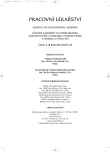Contribution of a Nasal Provocation Test for Diagnostics of the Occupational Allergic Rhinitis
Authors:
K. Boušová 1; I. Krčmová 2; D. Ranná 1
Authors‘ workplace:
Klinika nemocí z povolání, Fakultní nemocnice a Lékařská fakulta Univerzity Karlovy Hradec Králové, zastupující přednostka
MUDr. Eva Korolová, Ph. D.
1; Ústav klinické imunologie a alergologie, Fakultní nemocnice a Lékařská fakulta Univerzity Karlovy Hradec Králové, přednosta
MUDr. Otakar Kopecký, CSc.
2
Published in:
Pracov. Lék., 58, 2006, No. 2, s. 57-61.
Category:
Original Papers
Overview
A nasal provocation test serves to detect the response of a nasal mucosa to provocation by a specific or nonspecific nasal stimulus. One of the indications of this examination is the assessment of a professional etiology of an allergic rhinitis. The test makes complete the basic diagnostic procedure of detection of an allergic IgE-related disease, especially in case of a very suspect history but negative skin tests and specific IgE antibodies. A nasal provocation (challenge) test enables distinguishing the role of nonspecific and specific factors in development of nasal symptoms and follow-up of an early, late and delayed reaction. The active anterior rhinomanometry is a recommended method used as a nasal provocative test which measures: 1. an inspiration flow in each nasal nostril (determines the degree of a nasal obstruction), 2. a nasal resistance in each nasal nostril. Simultaneously, a so called nasal symptom score is evaluated.
The incidence of a occupational allergic rhinitis in the Czech Republic reported as an independent disease is roughly 30 new cases annually and next 40 to 70 new cases of the disease combined with asthma bronchiale annually. Similarly to asthma bronchiale, the most affected professions are bakers, confectioners, cereal producers, cattle breeders, textile workers, nurses and workers exposed to isocyanates and other chemicals.
Data from the sample of 70 persons are presented and reflect reporting of a occupational allergic rhinitis (33 patients) and in combination with asthma bronchiale (37 patients) by the Clinic of Occupational Diseases of the Teaching Hospital in Hradec Králové in 1996–2004. Flour and mill dust (27 %), textile dust (14 %), vegetable dust (10 %), disinfectant products (9 %), cow epithelium (7 %) and latex (7 %) were the most frequent allergens. The average length of exposure to a particular professional noxae until the development of the first allergic symptoms was 9 ± 10,05 years.
A nasal provocation test contributed to diagnosing the occupational allergic rhinitis in 20 % patients (14/70).
The authors support the efforts to unification of the procedure of a nasal provocative test on the national and international level.
Key words:
nasal provocation test, occupational allergic rhinitis, active anterior rhinomanometry
Labels
Hygiene and epidemiology Hyperbaric medicine Occupational medicineArticle was published in
Occupational Medicine

2006 Issue 2
Most read in this issue
- Spirometry in Clinical Practice
- A Nasal Provocation Test in Occupational Medicine: Recommended Procedure – Methods
- Bird Flu
- Problems Related to the Assessment of Dynamics of Development of Pneumoconioses
